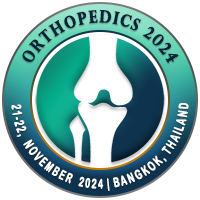
Ahmed Sonbol
International Medical Center, Saudi ArabiaTitle: Intrawound low-dose vancomycin is superior to high-dose in controlling the risk of wound dehiscence in spine surgeries
Abstract
Wound complications in spine surgeries are common and serious. This study aimed to determine the risk of wound dehiscence with a low-dose of intrawound vancomycin compared to that with a high-dose and no-vancomycin and its effectiveness in the prevention of surgical site infection. Patients were categorized into 3 groups. The first group did not receive any intrawound vancomycin. In the second, patients received a high-dose of vancomycin (1 g). The third group included patients who received a low-dose of intrawound vancomycin (250 mg). Patient demographics, clinical data, and surgical data were also collected. Multivariate linear regression analysis was used to examine factors associated with dehiscence or infection. Of the 391 patients included in our study, 56 (14.3%) received a high-dose of intrawound vancomycin, 126 (32.2%) received a low-dose, and 209 (53.5%) did not receive any treatment. The overall incidence of wound dehiscence was 6.14% (24 out of 391 patients). Wound dehiscence was significantly higher (P = .039) in the high-dose vancomycin group than in the low-dose vancomycin group. The overall incidence of postoperative infection was 2.05% (8 patients) and no statistically significant differences were observed between the low-dose and high-dose vancomycin groups. Patients with higher body mass index were more likely to experience wound dehiscence and postoperative infection, irrespective of the dose of vancomycin used. The use of low-dose intrawound vancomycin (250 mg) resulted in less wound dehiscence compared with high-dose vancomycin. Further trials are required to evaluate the effectiveness of the low-dose in preventing postoperative infections.
Biography
Ahmed Sonbol, Orthopedic and spine senior registrar, International Medical Center, Saudi Arabia

